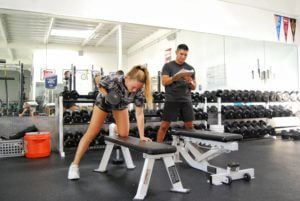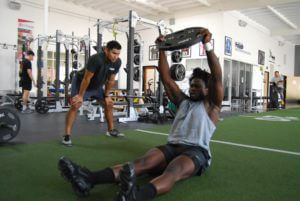Book An Appointment
Matt Camargo, MS, CSCS, Director of Performance
The best program for an individual to reach their goal is the program that produces the best opportunity for consistency. Too often individuals get stuck when overthinking occurs with the 'perfect' exercise or program. Perfect does not exist, what does exist is effort. When trying to determine what muscle groups to workout together - The first set of questions should be what are the training goals? Second, why do you want to achieve said goal(s)?
Formulating the purpose is paramount in influencing quality effort into achieving realistic goals. There are numerous exercise routines that claim to achieve X. There can be the ‘best’ exercise routine on paper, but means nothing if consistency and quality effort is not there.
Everyone wants to be better or improve at something, whether it is losing weight, increasing muscle mass, getting faster or stronger. That is a result, not a purpose. Everyone’s purpose will be different that comes from their why. Once a why is solidified, that is where the real fun begins in creating the program.
When the goal is efficiency and most reward with minimal risk - paring muscle groups that work well together are agonist and antagonist muscle groups, for example: when performing a dumbbell bicep curl the biceps will be the agonist as it contracts to execute the movement while the triceps will be the antagonist as it relaxes to allow movement to occur.
Same thing goes for hamstrings/glutes and quadriceps, chest and back then anterior deltoids and posterior deltoids. Another approach is pairing a lower-body exercise with an upper-body movement, examples are: Lunges paired with Chin-Ups or Romanian Deadlifts paired with Incline Dumbbell Bench Press.
It is best to target agonist with antagonist muscle groups because it allows for an efficient process in creating muscular balance from multiple angles. A lot of times early on when individuals exercise they spend more time on the quads, chest, anterior deltoids and biceps aka the ‘mirror’ muscles. Since that could be a potential issue, being intentional with agonist and antagonist pairings promotes the best opportunity for having adequate muscular balance in terms of health and muscular resiliency.
Pairing a lower body exercise with a upper-body exercise is also beneficial because it gives ample time to recover within the set. Lower body exercises predominantly cause more fatigue compared to upper body exercises due to their physiology. While the legs are recovering, in theory you could perform an upper body exercise and repeat this for several sets leading to good results.

Agonist & Antagonist
Horizontal Pressing Exercises such as push up and bench press variations paired with Horizontal Pulling Exercises such as all row variations, whether it is a barbell, dumbbell or machines.
Vertical Pressing such as shoulder press variations paired with Vertical Pulling exercises such as pull-up/chin-up variations as well as banded or cable pulls.
Lower Body Push exercises such as squats and lunge variations paired with lower body pulling exercises such as deadlift and glute bridge variations.

Lower Body & Upper Body
Front Squat or Back Squat paired with Chin-ups or Dumbbell Rows
Walking Lunge or Reverse Lunge paired with Barbell row or inverted rows
Deadlift or romanian deadlifts paired with push-ups or bench press variations
What readers should also know about getting an effective and efficient workout is having sport-performance related goals or general fitness goals have a lot of similarities but specific differences.
Understanding exercise choice and order is very important when it comes to putting together a routine. Some exercises need more rest than others due to the physical requirements in order to perform them. Some exercises cause a lot of good training stress at the trunk aka the core as well as stabilizers around the shoulder or hip joints. Understanding how one exercise influences the other is critical to getting efficient results.
When training for sport it is for preventing sport injuries, and increasing speed or power. When training for general fitness typically it is mainly for losing weight or increasing lean body mass, not always but a nonathlete is more prone to not care about jumping higher or increasing their acceleration mechanics.
Athletes need to be able to achieve specific athletic movements at high levels against the competition. Nonathletes which are general fitness enthusiasts, need to feel good/look good - which can be different for a lot of individuals on how they define being healthy or in shape. When dealing with athletes, the goals are the same for the needs of their sport or position.
Focusing too much on being perfect can negatively influence individuals to where they get discouraged and just stop trying. The issue of chasing perfection is it does not exist, it sets false expectations.
Sure, it may work for some individuals but the harsh reality is a lot of people do not have the necessary tools and support to approach training or exercising with an all-or-nothing approach.
A simple recipe for success is to write down 1-2 goals, then 1-2 ways those goals can be achieved then next be consistent with those decisions for a minimum of 30 days THEN reevaluate and adjust where needed.
Notifications